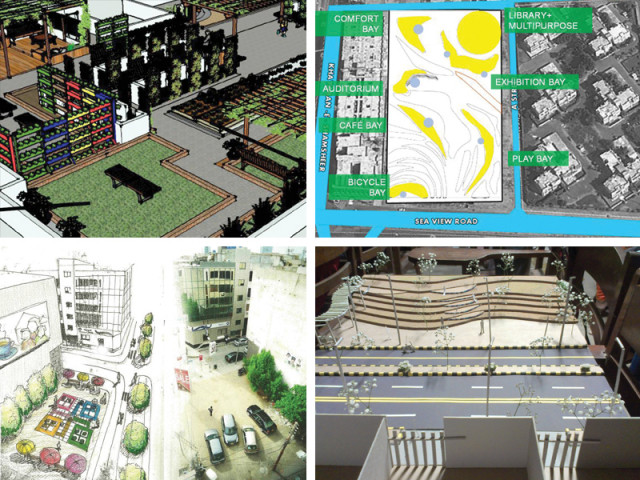Undergrad students come up with Karachi solutions - what’s stopping the govt?
IVSAA students give four visionary ideas for sustainability.

Fourth-year architecture students at Indus Valley School came up with four visionary models to promote sustainable living practices in Karachi. Each group worked on separate sustainable neighbourhood determinants, namely, walkability and bicycling, streetscaping, green infrastructure and a neighbourhood centre design. PHOTOS COURTESY: IVS STUDENTS AND FARHAN ANWAR
In response, we have entered the age of ‘strategic planning’. Gone are the days when grand ‘City Master Plans’ were being prepared, dictated by a ‘modern era’ construct of expansion, segregation and large-scale infrastructure development. Instead we have strategic planning in which we work with what we have, innovate, conserve and simplify. We exit energy consumption, carbon emission and city expansion, eschewing the motor vehicle to travel in public transport, carpool, bike and walk. The ‘futuristic city’ is not about people flying in pods in the air but about families walking on the streets, and children playing in parks.
The design triggers for the ‘futuristic’ cities are also different. Earlier on, grand highways defined the city fabric, but now the focus is on promoting public transport, going from urban sprawl to a compact city model. Public transport precipitates transit-oriented development, in which priority is given to the pedestrian rather than the car owner.
Climate change now determines the design of futuristic housing and infrastructure. This is the age of the smart city, the sustainable city. The holy grail of sustainable development is defined by growth that offers financial viability but which does not compromise on environmental sensitivities. The dividends of growth are equitably shared. We are moving from a gated city model to the dream of an inclusive city.
But here, in this Land of the Pure where we are rapidly multiplying and rapidly urbanising, what is our vision? According to the ‘Task Force Report on Urban Development, 2011, Planning Commission, Government of Pakistan’, our urban population is estimated to surpass 121 million by the year 2030. The level of urbanisation of 45.6 per cent would then be the highest in South East Asia.
In the Karachi megacity, everything seems to be going against the grain of a sustainable city. The city is expanding unplanned and unregulated, we are being pigeon-holed into gated neighbourhoods, losing green spaces, building infrastructure to promote private vehicle use while criminally failing to invest in public transport options. The list is long and depressing. But there are some silver linings also. At least people have started to talk about change and most encouraging is the level of commitment of our youth to improving the city despite all the discouraging and inhibiting constraints.
One such visionary exercise was recently carried out by fourth-year architecture students at the Indus Valley School of Arts and Architecture in Karachi where four visionary models to promote sustainable living practices were developed. Students participated in an architecture and urban design project for which each group worked on separate sustainable neighbourhood determinants, namely, walkability and bicycling, streetscaping, green infrastructure (rooftop garden/farm) and a neighbourhood centre design.
In the Hill Park neighbourhood the students designed routes, mobility hubs and street furniture to encourage increased walking and bicycling. The group that designed a multi-use ‘neighbourhood community centre’ in the Sea View area looked at how re-imagining spaces could promote greater integration of communities. The group working on ‘green infrastructure’ designed a ‘rooftop farm/garden’ in a selected apartment complex in the Bath Island neighbourhood, while one group developed a comprehensive vision and supporting design to make the Zamzama shopping district a ‘traffic free’ and ‘pedestrian friendly’ space to promote an active street life.
It took a group of undergraduate students a few months to come up with extremely innovative, exciting and workable ideas and designs. What is stopping our decision-makers, planners and government institutions from doing the same or at least benefiting from others?
The writer is an urban planner and runs a non-profit organization based in Karachi city focusing on urban sustainability issues. He can be reached at fanwar@sustainableinitiatives.org.pk
The dream team
These groups of IVS students came up with the four models for sustainable Karachi:
Sea View Community Centre:
Alyzeh Rizvi, Abdul Fateh Saif, Mohammad Daniyal Tariq, Syed Dawood Shah, Syed Haseeb Amjad
Zamzama Streetscape Design:
Hira Noor, Shahzaib
Arif Shaikh, Mishaal
Rahim, Marium Rehman,
Zeeshan Ali
Karachi rooftops: the forgotten spaces:
Syed Ali Aun Raza Shamsi, Nida Shahid Mansoor, Nida Ali, Omair Ahmed Tanveer, Sana Jamal, Maheen Rashid
Walkability and Cycling: Fatema Irfan Ali, Huzefah Haroon, Marvi Jawed, Nimra Nagi, Saadia Shahid, Sonam Khan Rafat, Tooba Jalal
Published in The Express Tribune, September 30th, 2013.

















COMMENTS
Comments are moderated and generally will be posted if they are on-topic and not abusive.
For more information, please see our Comments FAQ